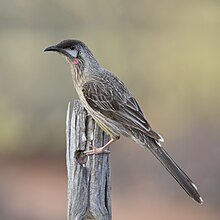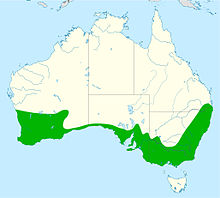Anthochaera carunculata
| Red wattlebird | |
|---|---|
 |
|
| Scientific classification | |
| Kingdom: | Animalia |
| Phylum: | Chordata |
| Class: | Aves |
| Order: | Passeriformes |
| Family: | Meliphagidae |
| Genus: | Anthochaera |
| Species: | A. carunculata |
| Binomial name | |
|
Anthochaera carunculata (Shaw, 1790) |
|
 |
|
| Distribution map of the red wattlebird | |
The red wattlebird (Anthochaera carunculata) is a passerine bird native to southern Australia. At 33–37 cm (13–14 1⁄2 in) in length, it is the second largest species of Australian honeyeater. It has mainly grey-brown plumage, with red eyes, distinctive pinkish-red wattles on either side of the neck, white streaks on the chest and a large bright yellow patch on the lower belly. The sexes are similar in plumage. Juveniles have less prominent wattles and browner eyes. John White described the red wattlebird in 1790; three subspecies are recognized.
The species is found in southeast Queensland, New South Wales, Victoria, South Australia and southwest Western Australia in open forest and woodland, and is a common visitor to urban gardens and parks. Loud and conspicuous, the red wattlebird is generally found in trees, where it gets most of its food; occasionally it forages on the ground. It is one of the largest nectarivorous birds in the world, feeding from a wide variety of flowering plants. Insects also comprise part of its diet. It is territorial and at times aggressive to birds of other species, often defending rich sources of nectar. Breeding throughout its range, the red wattlebird builds a cup-shaped nest in a tree and raises one to two broods a year. Although it has declined in places from land clearing, it is classified as Least Concern on the IUCN Red List.
The red wattlebird was first described as the wattled bee-eater by the Irish surgeon and naturalist John White in his Journal of a Voyage to New South Wales, which was published in 1790. He wrote that it was the "size of a missel thrush, but much larger in proportion". The taxonomic descriptions in White's book are believed to have been written by the English naturalist George Shaw, who is generally credited as the author by subsequent authorities. The specific epithet, carunculata, was introduced later in the same year by John Latham. The word is derived from caruncula, Latin for a small piece of flesh. Both Shaw and Latham assigned the red wattlebird to the genus Merops. The species was moved to Anthochaera in 1827 by the naturalists Nicholas Aylward Vigors and Thomas Horsfield.
...
Wikipedia

